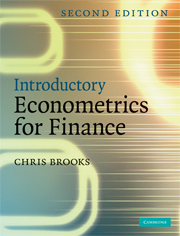Book contents
- Frontmatter
- Contents
- List of figures
- List of tables
- List of boxes
- List of screenshots
- Preface to the second edition
- Acknowledgements
- 1 Introduction
- 2 A brief overview of the classical linear regression model
- 3 Further development and analysis of the classical linear regression model
- 4 Classical linear regression model assumptions and diagnostic tests
- 5 Univariate time series modelling and forecasting
- 6 Multivariate models
- 7 Modelling long-run relationships in finance
- 8 Modelling volatility and correlation
- 9 Switching models
- 10 Panel data
- 11 Limited dependent variable models
- 12 Simulation methods
- 13 Conducting empirical research or doing a project or dissertation in finance
- 14 Recent and future developments in the modelling of financial time series
- Appendix 1 A review of some fundamental mathematical and statistical concepts
- Appendix 2 Tables of statistical distributions
- Appendix 3 Sources of data used in this book
- References
- Index
5 - Univariate time series modelling and forecasting
- Frontmatter
- Contents
- List of figures
- List of tables
- List of boxes
- List of screenshots
- Preface to the second edition
- Acknowledgements
- 1 Introduction
- 2 A brief overview of the classical linear regression model
- 3 Further development and analysis of the classical linear regression model
- 4 Classical linear regression model assumptions and diagnostic tests
- 5 Univariate time series modelling and forecasting
- 6 Multivariate models
- 7 Modelling long-run relationships in finance
- 8 Modelling volatility and correlation
- 9 Switching models
- 10 Panel data
- 11 Limited dependent variable models
- 12 Simulation methods
- 13 Conducting empirical research or doing a project or dissertation in finance
- 14 Recent and future developments in the modelling of financial time series
- Appendix 1 A review of some fundamental mathematical and statistical concepts
- Appendix 2 Tables of statistical distributions
- Appendix 3 Sources of data used in this book
- References
- Index
Summary
Learning Outcomes
In this chapter, you will learn how to
Explain the defining characteristics of various types of stochastic processes
Identify the appropriate time series model for a given data series
Produce forecasts for ARMA and exponential smoothing models
Evaluate the accuracy of predictions using various metrics
Estimate time series models and produce forecasts from them in EViews
Introduction
Univariate time series models are a class of specifications where one attempts to model and to predict financial variables using only information contained in their own past values and possibly current and past values of an error term. This practice can be contrasted with structural models, which are multivariate in nature, and attempt to explain changes in a variable by reference to the movements in the current or past values of other (explanatory) variables. Time series models are usually a-theoretical, implying that their construction and use is not based upon any underlying theoretical model of the behaviour of a variable. Instead, time series models are an attempt to capture empirically relevant features of the observed data that may have arisen from a variety of different (but unspecified) structural models. An important class of time series models is the family of AutoRegressive Integrated Moving Average (ARIMA) models, usually associated with Box and Jenkins (1976). Time series models may be useful when a structural model is inappropriate. For example, suppose that there is some variable yt whose movements a researcher wishes to explain.
Information
- Type
- Chapter
- Information
- Introductory Econometrics for Finance , pp. 206 - 264Publisher: Cambridge University PressPrint publication year: 2008
Accessibility standard: Unknown
Why this information is here
This section outlines the accessibility features of this content - including support for screen readers, full keyboard navigation and high-contrast display options. This may not be relevant for you.Accessibility Information
- 2
- Cited by
